Economic Assignment
VerifiedAdded on 2023/06/12
|14
|2965
|219
AI Summary
This assignment discusses exercise tax on tobacco products, short run output in a perfectly competitive market, and the difference between oligopoly and monopolistic competition. It also explains the economic rationale for government amalgamation in Australia.
Contribute Materials
Your contribution can guide someone’s learning journey. Share your
documents today.
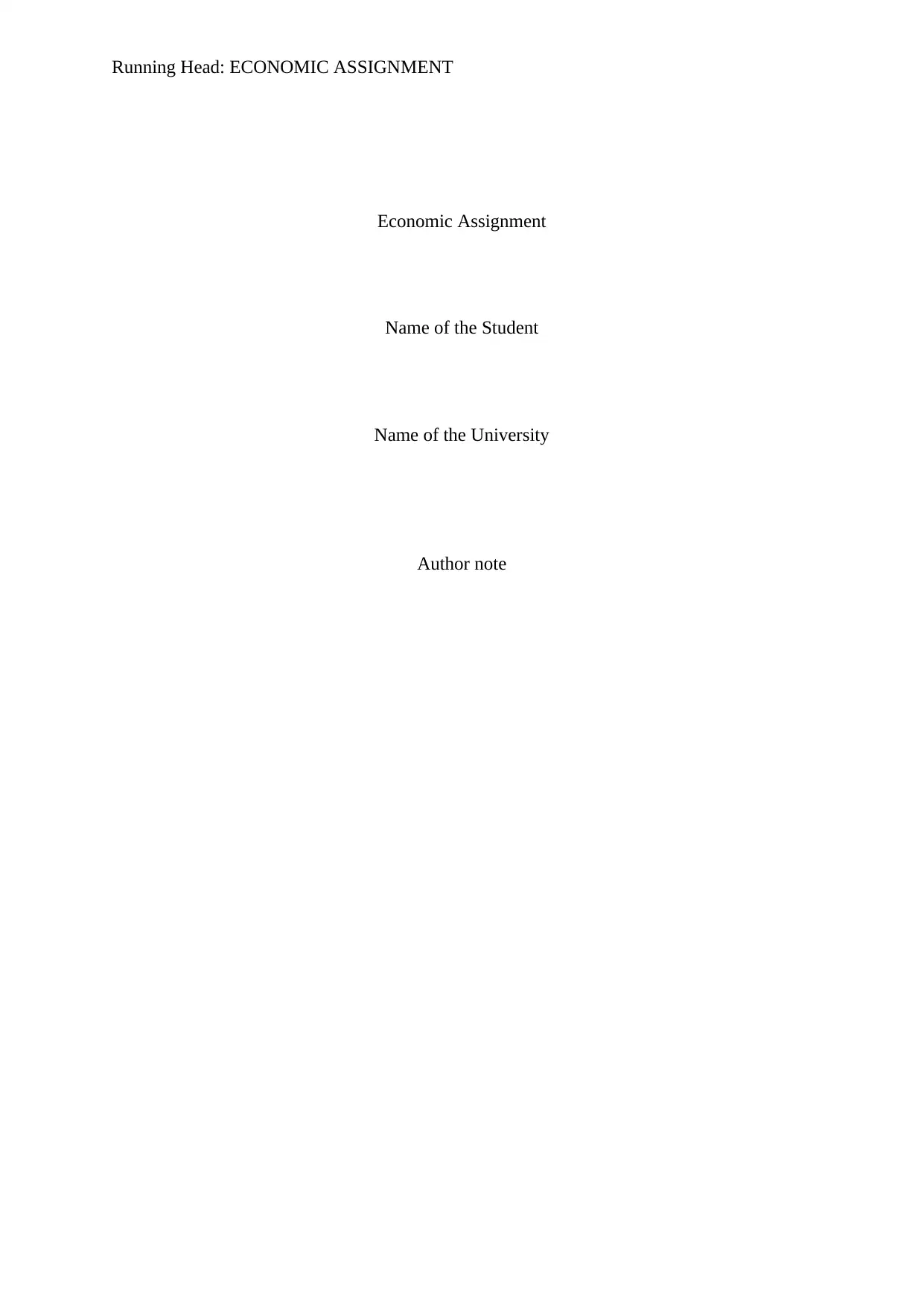
Running Head: ECONOMIC ASSIGNMENT
Economic Assignment
Name of the Student
Name of the University
Author note
Economic Assignment
Name of the Student
Name of the University
Author note
Secure Best Marks with AI Grader
Need help grading? Try our AI Grader for instant feedback on your assignments.
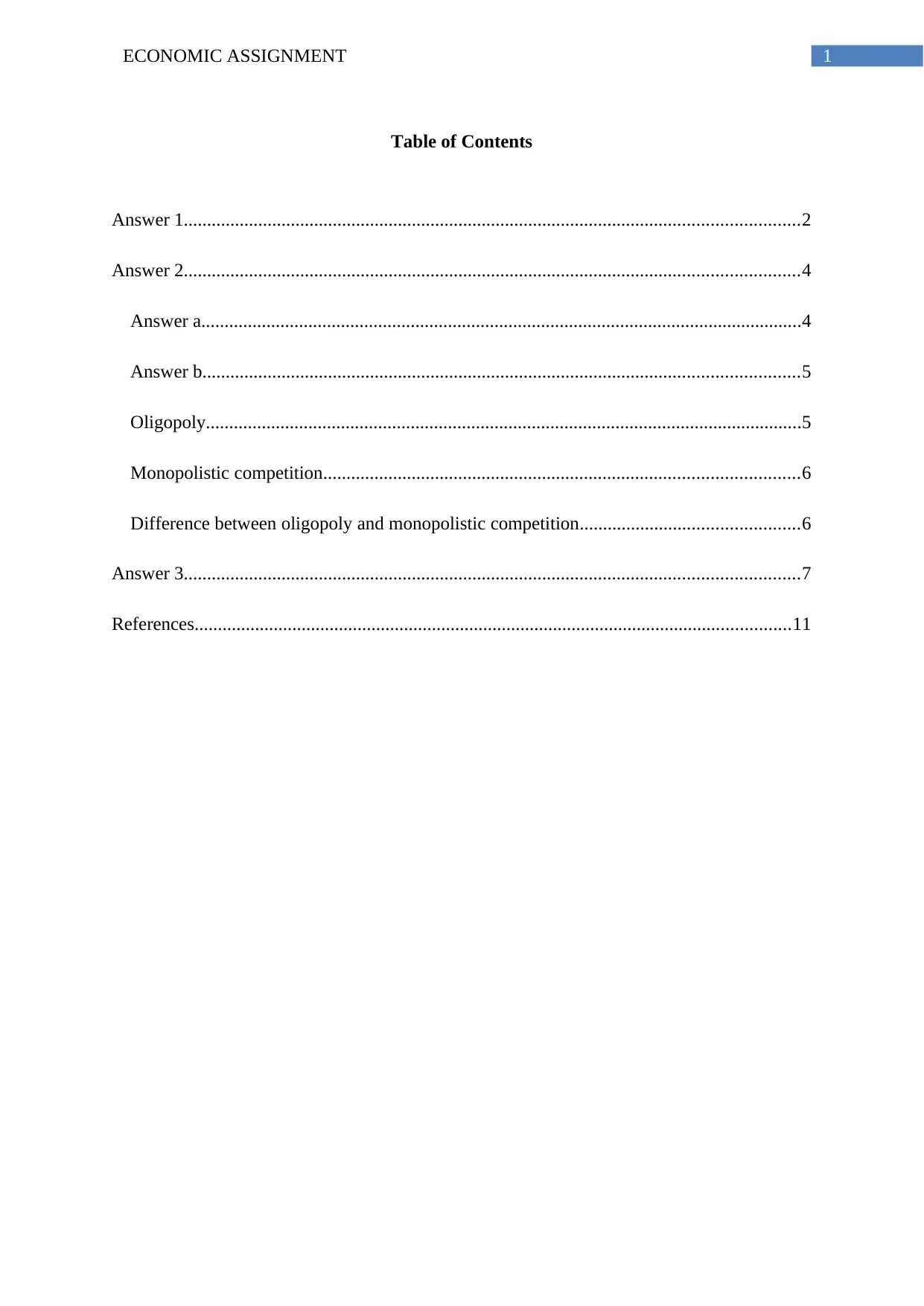
1ECONOMIC ASSIGNMENT
Table of Contents
Answer 1....................................................................................................................................2
Answer 2....................................................................................................................................4
Answer a.................................................................................................................................4
Answer b................................................................................................................................5
Oligopoly................................................................................................................................5
Monopolistic competition......................................................................................................6
Difference between oligopoly and monopolistic competition...............................................6
Answer 3....................................................................................................................................7
References................................................................................................................................11
Table of Contents
Answer 1....................................................................................................................................2
Answer 2....................................................................................................................................4
Answer a.................................................................................................................................4
Answer b................................................................................................................................5
Oligopoly................................................................................................................................5
Monopolistic competition......................................................................................................6
Difference between oligopoly and monopolistic competition...............................................6
Answer 3....................................................................................................................................7
References................................................................................................................................11

2ECONOMIC ASSIGNMENT
Answer 1
In Australia, an exercise tax of 0.71046 is applicable on per sticks of Tobacco weighting less
than 0.8 gram. (ato.gov.au, 2018).
Tax for a pack of 20 cigarettes is therefore ($20*0.71046) = $14.2092
The packet is sold for $30. Hence, the price without tax is
( $ 30−$ 14.2092 )=$ 15.79
Hence, the pre-tax price of the packet of cigarette is $15.79.
In case of an indirect tax like sales or exercise tax, sellers by pass the tax burden to
the buyers. As a result the tax burden is divided between buyers and sellers. The burden
however is not equally divided between buyers and sellers. The price elasticity of demand has
a major role play here. The price elasticity of demand measures the proportionate change in
demand of a good in response to the proportionate change in price. A high value of elasticity
implies a greater flexibility of demand and vice versa. Commodities are said to have a
relatively elastic demand if the magnitude of demand change is greater than the
corresponding change in price. The measured elasticity is here greater than one (Mankiw &
Cosgrove, 2014). The slight change in price then leads to a greater change in demand. If
demand is relatively elastic in nature, an increased price because of imposition of tax lead to
a greater reduction in demand on part of the consumers. Hence, buyers have to bear a
relatively less burden of tax. Opposite is the case for a relatively inelastic demand. A
relatively inelastic demand in one where demand cannot adjust much despite change in price.
The measured elasticity here is less than one. If tax is imposed on goods having a relatively
inelastic demand then buyers have to bear a greater burden of tax because of stringent nature
of demand. Therefore, the effect of exercise tax on tobacco product depends on the nature of
demand. Tobacco products are considered as addictive items. People do not have much
Answer 1
In Australia, an exercise tax of 0.71046 is applicable on per sticks of Tobacco weighting less
than 0.8 gram. (ato.gov.au, 2018).
Tax for a pack of 20 cigarettes is therefore ($20*0.71046) = $14.2092
The packet is sold for $30. Hence, the price without tax is
( $ 30−$ 14.2092 )=$ 15.79
Hence, the pre-tax price of the packet of cigarette is $15.79.
In case of an indirect tax like sales or exercise tax, sellers by pass the tax burden to
the buyers. As a result the tax burden is divided between buyers and sellers. The burden
however is not equally divided between buyers and sellers. The price elasticity of demand has
a major role play here. The price elasticity of demand measures the proportionate change in
demand of a good in response to the proportionate change in price. A high value of elasticity
implies a greater flexibility of demand and vice versa. Commodities are said to have a
relatively elastic demand if the magnitude of demand change is greater than the
corresponding change in price. The measured elasticity is here greater than one (Mankiw &
Cosgrove, 2014). The slight change in price then leads to a greater change in demand. If
demand is relatively elastic in nature, an increased price because of imposition of tax lead to
a greater reduction in demand on part of the consumers. Hence, buyers have to bear a
relatively less burden of tax. Opposite is the case for a relatively inelastic demand. A
relatively inelastic demand in one where demand cannot adjust much despite change in price.
The measured elasticity here is less than one. If tax is imposed on goods having a relatively
inelastic demand then buyers have to bear a greater burden of tax because of stringent nature
of demand. Therefore, the effect of exercise tax on tobacco product depends on the nature of
demand. Tobacco products are considered as addictive items. People do not have much

3ECONOMIC ASSIGNMENT
incentive to reduce demand in response to a high price. Studies found that for tobacco
products the proportionate change in demand is less than the change in price (aph.gov.au
2018). The effect of an imposed tax on tobacco seller is described in the figure below.
Figure 1: Impact of exercise tax on tobacco market
(Source: as created by Author)
The demand and supply curve for tobacco products is given by DD and SS. Because of a
relatively inelastic demand if tobacco products, the demand curve is steeper than the supply
curve. Before tax, price and quantity in the market is determined by the intersection of
demand and supply curve. E is the equilibrium point with an associated equilibrium price and
quantity of P1 and Q1 respectively. Now consider a tax of the amount ‘t’ is imposed on seller.
As the tax imposed on seller the immediate effect of tax is on the supply curve. Tax on seller
discourages seller leading to a reduction in the effective supply (Taylor et al, 2014). This is
shown by a leftward shift of the supply curve by the amount of tax. The new supply curve is
incentive to reduce demand in response to a high price. Studies found that for tobacco
products the proportionate change in demand is less than the change in price (aph.gov.au
2018). The effect of an imposed tax on tobacco seller is described in the figure below.
Figure 1: Impact of exercise tax on tobacco market
(Source: as created by Author)
The demand and supply curve for tobacco products is given by DD and SS. Because of a
relatively inelastic demand if tobacco products, the demand curve is steeper than the supply
curve. Before tax, price and quantity in the market is determined by the intersection of
demand and supply curve. E is the equilibrium point with an associated equilibrium price and
quantity of P1 and Q1 respectively. Now consider a tax of the amount ‘t’ is imposed on seller.
As the tax imposed on seller the immediate effect of tax is on the supply curve. Tax on seller
discourages seller leading to a reduction in the effective supply (Taylor et al, 2014). This is
shown by a leftward shift of the supply curve by the amount of tax. The new supply curve is
Secure Best Marks with AI Grader
Need help grading? Try our AI Grader for instant feedback on your assignments.
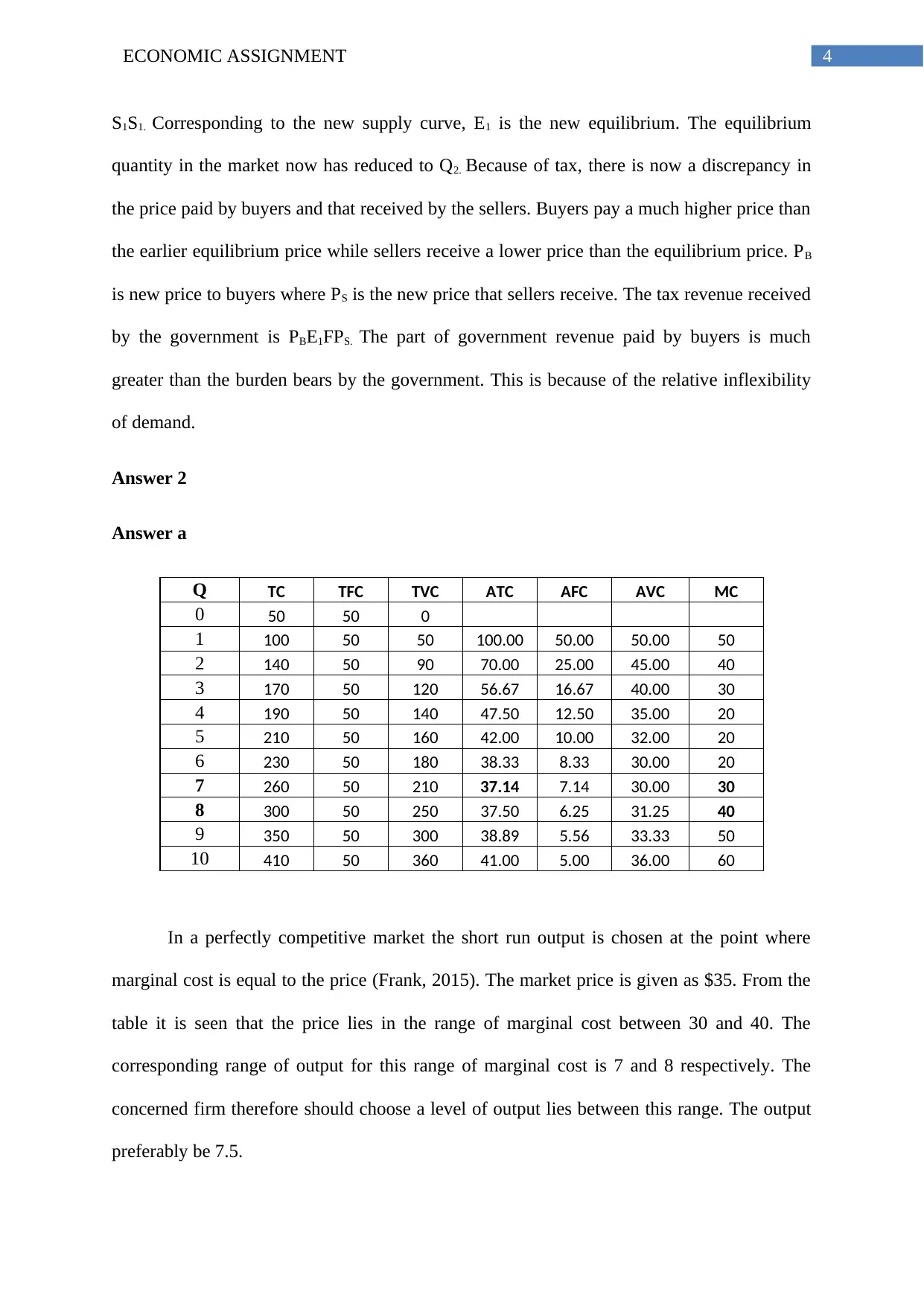
4ECONOMIC ASSIGNMENT
S1S1. Corresponding to the new supply curve, E1 is the new equilibrium. The equilibrium
quantity in the market now has reduced to Q2. Because of tax, there is now a discrepancy in
the price paid by buyers and that received by the sellers. Buyers pay a much higher price than
the earlier equilibrium price while sellers receive a lower price than the equilibrium price. PB
is new price to buyers where PS is the new price that sellers receive. The tax revenue received
by the government is PBE1FPS. The part of government revenue paid by buyers is much
greater than the burden bears by the government. This is because of the relative inflexibility
of demand.
Answer 2
Answer a
Q TC TFC TVC ATC AFC AVC MC
0 50 50 0
1 100 50 50 100.00 50.00 50.00 50
2 140 50 90 70.00 25.00 45.00 40
3 170 50 120 56.67 16.67 40.00 30
4 190 50 140 47.50 12.50 35.00 20
5 210 50 160 42.00 10.00 32.00 20
6 230 50 180 38.33 8.33 30.00 20
7 260 50 210 37.14 7.14 30.00 30
8 300 50 250 37.50 6.25 31.25 40
9 350 50 300 38.89 5.56 33.33 50
10 410 50 360 41.00 5.00 36.00 60
In a perfectly competitive market the short run output is chosen at the point where
marginal cost is equal to the price (Frank, 2015). The market price is given as $35. From the
table it is seen that the price lies in the range of marginal cost between 30 and 40. The
corresponding range of output for this range of marginal cost is 7 and 8 respectively. The
concerned firm therefore should choose a level of output lies between this range. The output
preferably be 7.5.
S1S1. Corresponding to the new supply curve, E1 is the new equilibrium. The equilibrium
quantity in the market now has reduced to Q2. Because of tax, there is now a discrepancy in
the price paid by buyers and that received by the sellers. Buyers pay a much higher price than
the earlier equilibrium price while sellers receive a lower price than the equilibrium price. PB
is new price to buyers where PS is the new price that sellers receive. The tax revenue received
by the government is PBE1FPS. The part of government revenue paid by buyers is much
greater than the burden bears by the government. This is because of the relative inflexibility
of demand.
Answer 2
Answer a
Q TC TFC TVC ATC AFC AVC MC
0 50 50 0
1 100 50 50 100.00 50.00 50.00 50
2 140 50 90 70.00 25.00 45.00 40
3 170 50 120 56.67 16.67 40.00 30
4 190 50 140 47.50 12.50 35.00 20
5 210 50 160 42.00 10.00 32.00 20
6 230 50 180 38.33 8.33 30.00 20
7 260 50 210 37.14 7.14 30.00 30
8 300 50 250 37.50 6.25 31.25 40
9 350 50 300 38.89 5.56 33.33 50
10 410 50 360 41.00 5.00 36.00 60
In a perfectly competitive market the short run output is chosen at the point where
marginal cost is equal to the price (Frank, 2015). The market price is given as $35. From the
table it is seen that the price lies in the range of marginal cost between 30 and 40. The
corresponding range of output for this range of marginal cost is 7 and 8 respectively. The
concerned firm therefore should choose a level of output lies between this range. The output
preferably be 7.5.

5ECONOMIC ASSIGNMENT
As seen from the table the short run price is below the average total cost. This implies
the firm in incurring a loss in the short run. The price lies above the minimum average
variable cost, which equals to $30. The firm should continue production in the short run as
long run price is above the minimum average variable cost. In the long run, price is $35. This
is lower than minimum average cost of 37.14. The long run price in the perfectly competitive
market can be as low as minimum of the average cost (Becker, 2017). The loss making firm
in the short run hence would leave the market.
Answer b
There is a considerable differences in definition of market from the perspective of
marketers and that from economists. In economics, market defines a transaction relation
which goes beyond the physical location. The aim of economists is to view the overall
structure of the market with giving particular focus on behavior of buyers and sellers. The
analysis of market structure is mostly based on the number of competing firms present in the
industry. The four common form of market include perfect competition, monopoly, oligopoly
and monopolistic competition (Yang & Ng, 2015). Both monopolistic competition and
oligopoly belong to the category of imperfectly competitive market structure.
Oligopoly
This form of market includes a relatively small number of competing firms in the
industry. The few firms create considerable barriers to the entry of new firms in the industry.
The large sized firms enjoy a considerably high market share leading to high concentration in
the market (McKenzie & Lee, 2016). The firms the oligopoly market always have a close
look at its competitors. Each firms keep information about the competitors’ strategy and
incorporate the information in determining its own strategy. The grocery supermarket
structure, Australian airlines are some examples of oligopoly market in Australia.
As seen from the table the short run price is below the average total cost. This implies
the firm in incurring a loss in the short run. The price lies above the minimum average
variable cost, which equals to $30. The firm should continue production in the short run as
long run price is above the minimum average variable cost. In the long run, price is $35. This
is lower than minimum average cost of 37.14. The long run price in the perfectly competitive
market can be as low as minimum of the average cost (Becker, 2017). The loss making firm
in the short run hence would leave the market.
Answer b
There is a considerable differences in definition of market from the perspective of
marketers and that from economists. In economics, market defines a transaction relation
which goes beyond the physical location. The aim of economists is to view the overall
structure of the market with giving particular focus on behavior of buyers and sellers. The
analysis of market structure is mostly based on the number of competing firms present in the
industry. The four common form of market include perfect competition, monopoly, oligopoly
and monopolistic competition (Yang & Ng, 2015). Both monopolistic competition and
oligopoly belong to the category of imperfectly competitive market structure.
Oligopoly
This form of market includes a relatively small number of competing firms in the
industry. The few firms create considerable barriers to the entry of new firms in the industry.
The large sized firms enjoy a considerably high market share leading to high concentration in
the market (McKenzie & Lee, 2016). The firms the oligopoly market always have a close
look at its competitors. Each firms keep information about the competitors’ strategy and
incorporate the information in determining its own strategy. The grocery supermarket
structure, Australian airlines are some examples of oligopoly market in Australia.

6ECONOMIC ASSIGNMENT
Monopolistic competition
As suggested by the name, monopolistic competition is a form of market having
features of both monopoly and competitive market. Like competitive market, a large number
of firms present in the market. In a monopolistic competition, there are different brands
selling a differentiated product (Devine et al., 2018). Each brand owner behaves like a
monopolist and takes independent decision. Some common examples of monopolistic
competition include coffee shops, dry cleaners, furniture stores, pharmacies and the like.
Difference between oligopoly and monopolistic competition
Price competition
Strategic interdependence is one major feature of oligopoly market. Any strategy
taken by one firm is immediately followed by its rival firms. For example, if one firm reduces
price of its products, the other firms follow the same. This kind of price competition in the
oligopoly market results in a price war (Moulin, 2014). For example, if Texaco plans to lower
it product price to grab a higher market share then has to consider the fact that other rivals
like British petroleum will also follow the same to counteract the strategy.
In monopolistic competition, as all the firms are selling similar kind of products. They
never engage in price competition. Non-price competition in the form of product
differentiation, advertising and improvement in product quality are more prevalent here
(Dollery, Kortt & De Souza, 2015).
Entry barriers
In monopolistic competition firm can freely enter or exit the industry. In times of
economic profit new firm enter the market while during economic loss firms leave the
industry. In the oligopoly market there exist high barriers to entry of new firms. The
Monopolistic competition
As suggested by the name, monopolistic competition is a form of market having
features of both monopoly and competitive market. Like competitive market, a large number
of firms present in the market. In a monopolistic competition, there are different brands
selling a differentiated product (Devine et al., 2018). Each brand owner behaves like a
monopolist and takes independent decision. Some common examples of monopolistic
competition include coffee shops, dry cleaners, furniture stores, pharmacies and the like.
Difference between oligopoly and monopolistic competition
Price competition
Strategic interdependence is one major feature of oligopoly market. Any strategy
taken by one firm is immediately followed by its rival firms. For example, if one firm reduces
price of its products, the other firms follow the same. This kind of price competition in the
oligopoly market results in a price war (Moulin, 2014). For example, if Texaco plans to lower
it product price to grab a higher market share then has to consider the fact that other rivals
like British petroleum will also follow the same to counteract the strategy.
In monopolistic competition, as all the firms are selling similar kind of products. They
never engage in price competition. Non-price competition in the form of product
differentiation, advertising and improvement in product quality are more prevalent here
(Dollery, Kortt & De Souza, 2015).
Entry barriers
In monopolistic competition firm can freely enter or exit the industry. In times of
economic profit new firm enter the market while during economic loss firms leave the
industry. In the oligopoly market there exist high barriers to entry of new firms. The
Paraphrase This Document
Need a fresh take? Get an instant paraphrase of this document with our AI Paraphraser

7ECONOMIC ASSIGNMENT
oligopoly market is often formed with government authorization with a limited number of
firms (Frank, 2015). The ownership over strategy resources, presence of high fixed cost often
work as an entry barriers in the market.
Long run profit
The monopolistically competitive firms in the long run can earn only a normal profit.
In the short run firms might enjoy an economic profit or suffer from an economic loss. If
there exists an economic profit, then new firms enter the market reducing profit. Firms
continue to enter unless profit reduced to a normal profit (Mankiw & Cosgrove, 2014).
In the oligopoly market however, high barriers to entry help the firms to restore a
supernormal profit even in the long run.
Answer 3
The decision of State government to merge with local government has resulted in a
substantial reduction in the number of local councils in Australia. The main rationale for such
merger is that substantial economic benefits are derived from a consolidated government
(Sarala et al., 2016). The economic rationale for such policies are as follows
Theory of fiscal federalism and optimum size of the community
The theory of fiscal federalism address the issue of whether the specific public goods
or services should be offered in a federation like Australia on a centralized or decentralized
manner. The main issue here is which public goods should be provided by which levels of
government (central, state and government). This is known as principle of correspondence.
As per this principle, the public goods should be provided by the lowest level that is local
government (Verhoest et al., 2016). The local government however provides public goods to
a specific region only. The benefits of some public goods extends beyond the local boundary.
oligopoly market is often formed with government authorization with a limited number of
firms (Frank, 2015). The ownership over strategy resources, presence of high fixed cost often
work as an entry barriers in the market.
Long run profit
The monopolistically competitive firms in the long run can earn only a normal profit.
In the short run firms might enjoy an economic profit or suffer from an economic loss. If
there exists an economic profit, then new firms enter the market reducing profit. Firms
continue to enter unless profit reduced to a normal profit (Mankiw & Cosgrove, 2014).
In the oligopoly market however, high barriers to entry help the firms to restore a
supernormal profit even in the long run.
Answer 3
The decision of State government to merge with local government has resulted in a
substantial reduction in the number of local councils in Australia. The main rationale for such
merger is that substantial economic benefits are derived from a consolidated government
(Sarala et al., 2016). The economic rationale for such policies are as follows
Theory of fiscal federalism and optimum size of the community
The theory of fiscal federalism address the issue of whether the specific public goods
or services should be offered in a federation like Australia on a centralized or decentralized
manner. The main issue here is which public goods should be provided by which levels of
government (central, state and government). This is known as principle of correspondence.
As per this principle, the public goods should be provided by the lowest level that is local
government (Verhoest et al., 2016). The local government however provides public goods to
a specific region only. The benefits of some public goods extends beyond the local boundary.

8ECONOMIC ASSIGNMENT
The benefit region of specific public goods thus provides rationale for an optimal community
size and hence for government amalgamation. The local government merger was conducted
in 2016 between Bankstown City and Canterbury city councils (strongercouncils.nsw.gov.au
2018). Following the merger 484 new community projects and services have been undertaken
benefitting public. The merged council has increased housing affordability of workers.
Economies of Scale
With increasing scale of operation firms often realize cost benefits where increasing
output associated with a decreasing average cost. For government amalgamation economies
of scale indicates a situation where the cost of government services decline along with
increases in set of population (Masser, 2014). After merger between local and state
government the increased jurisdiction size reduces per unit cost of the provided service both
by the consolidated government. By mergers Centerbury – Banksdown council is expected to
save $90 million over a period of ten years (strongercouncils.nsw.gov.au 2018).
Figure 2: Economies of scale from mergers
The benefit region of specific public goods thus provides rationale for an optimal community
size and hence for government amalgamation. The local government merger was conducted
in 2016 between Bankstown City and Canterbury city councils (strongercouncils.nsw.gov.au
2018). Following the merger 484 new community projects and services have been undertaken
benefitting public. The merged council has increased housing affordability of workers.
Economies of Scale
With increasing scale of operation firms often realize cost benefits where increasing
output associated with a decreasing average cost. For government amalgamation economies
of scale indicates a situation where the cost of government services decline along with
increases in set of population (Masser, 2014). After merger between local and state
government the increased jurisdiction size reduces per unit cost of the provided service both
by the consolidated government. By mergers Centerbury – Banksdown council is expected to
save $90 million over a period of ten years (strongercouncils.nsw.gov.au 2018).
Figure 2: Economies of scale from mergers
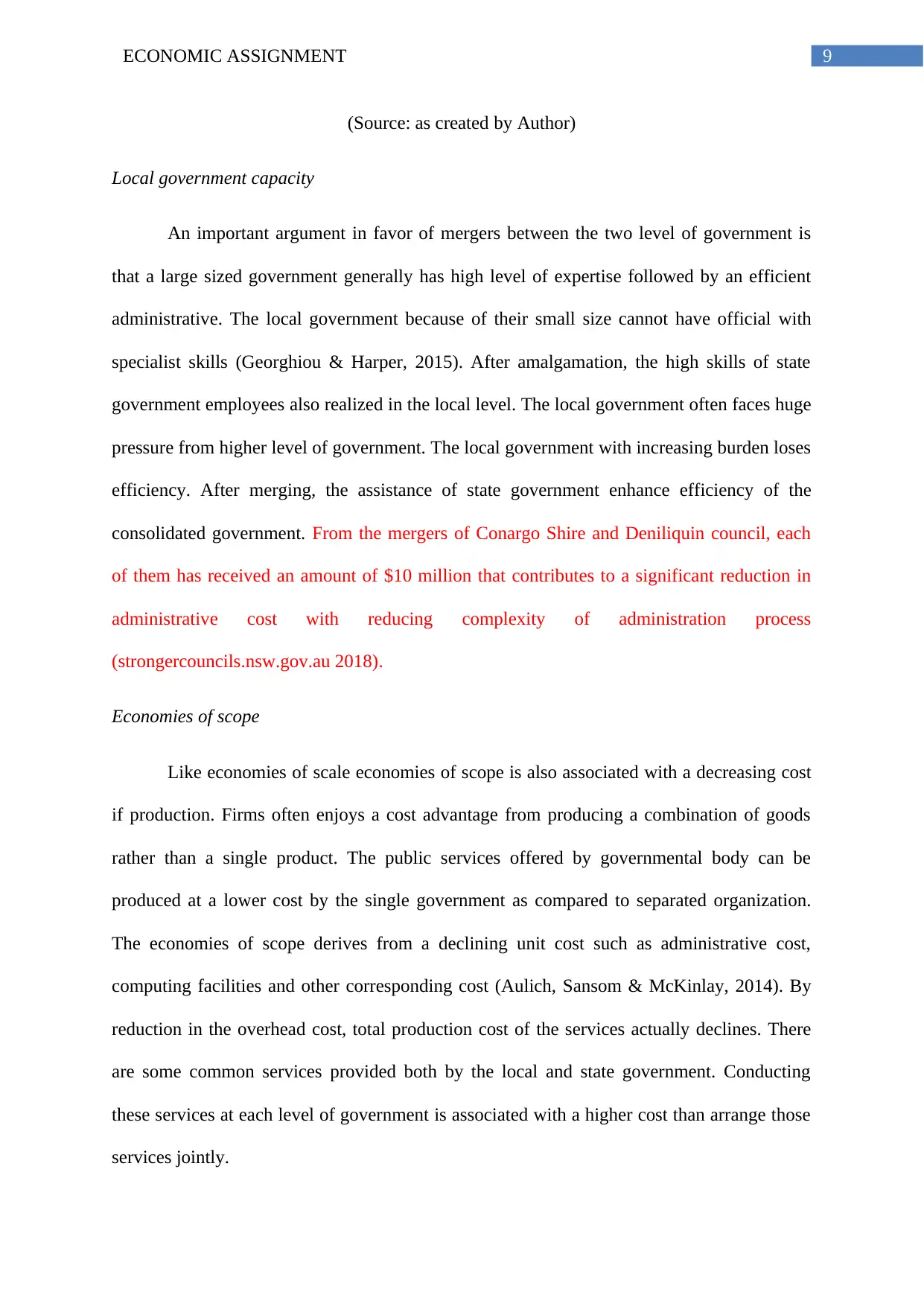
9ECONOMIC ASSIGNMENT
(Source: as created by Author)
Local government capacity
An important argument in favor of mergers between the two level of government is
that a large sized government generally has high level of expertise followed by an efficient
administrative. The local government because of their small size cannot have official with
specialist skills (Georghiou & Harper, 2015). After amalgamation, the high skills of state
government employees also realized in the local level. The local government often faces huge
pressure from higher level of government. The local government with increasing burden loses
efficiency. After merging, the assistance of state government enhance efficiency of the
consolidated government. From the mergers of Conargo Shire and Deniliquin council, each
of them has received an amount of $10 million that contributes to a significant reduction in
administrative cost with reducing complexity of administration process
(strongercouncils.nsw.gov.au 2018).
Economies of scope
Like economies of scale economies of scope is also associated with a decreasing cost
if production. Firms often enjoys a cost advantage from producing a combination of goods
rather than a single product. The public services offered by governmental body can be
produced at a lower cost by the single government as compared to separated organization.
The economies of scope derives from a declining unit cost such as administrative cost,
computing facilities and other corresponding cost (Aulich, Sansom & McKinlay, 2014). By
reduction in the overhead cost, total production cost of the services actually declines. There
are some common services provided both by the local and state government. Conducting
these services at each level of government is associated with a higher cost than arrange those
services jointly.
(Source: as created by Author)
Local government capacity
An important argument in favor of mergers between the two level of government is
that a large sized government generally has high level of expertise followed by an efficient
administrative. The local government because of their small size cannot have official with
specialist skills (Georghiou & Harper, 2015). After amalgamation, the high skills of state
government employees also realized in the local level. The local government often faces huge
pressure from higher level of government. The local government with increasing burden loses
efficiency. After merging, the assistance of state government enhance efficiency of the
consolidated government. From the mergers of Conargo Shire and Deniliquin council, each
of them has received an amount of $10 million that contributes to a significant reduction in
administrative cost with reducing complexity of administration process
(strongercouncils.nsw.gov.au 2018).
Economies of scope
Like economies of scale economies of scope is also associated with a decreasing cost
if production. Firms often enjoys a cost advantage from producing a combination of goods
rather than a single product. The public services offered by governmental body can be
produced at a lower cost by the single government as compared to separated organization.
The economies of scope derives from a declining unit cost such as administrative cost,
computing facilities and other corresponding cost (Aulich, Sansom & McKinlay, 2014). By
reduction in the overhead cost, total production cost of the services actually declines. There
are some common services provided both by the local and state government. Conducting
these services at each level of government is associated with a higher cost than arrange those
services jointly.
Secure Best Marks with AI Grader
Need help grading? Try our AI Grader for instant feedback on your assignments.
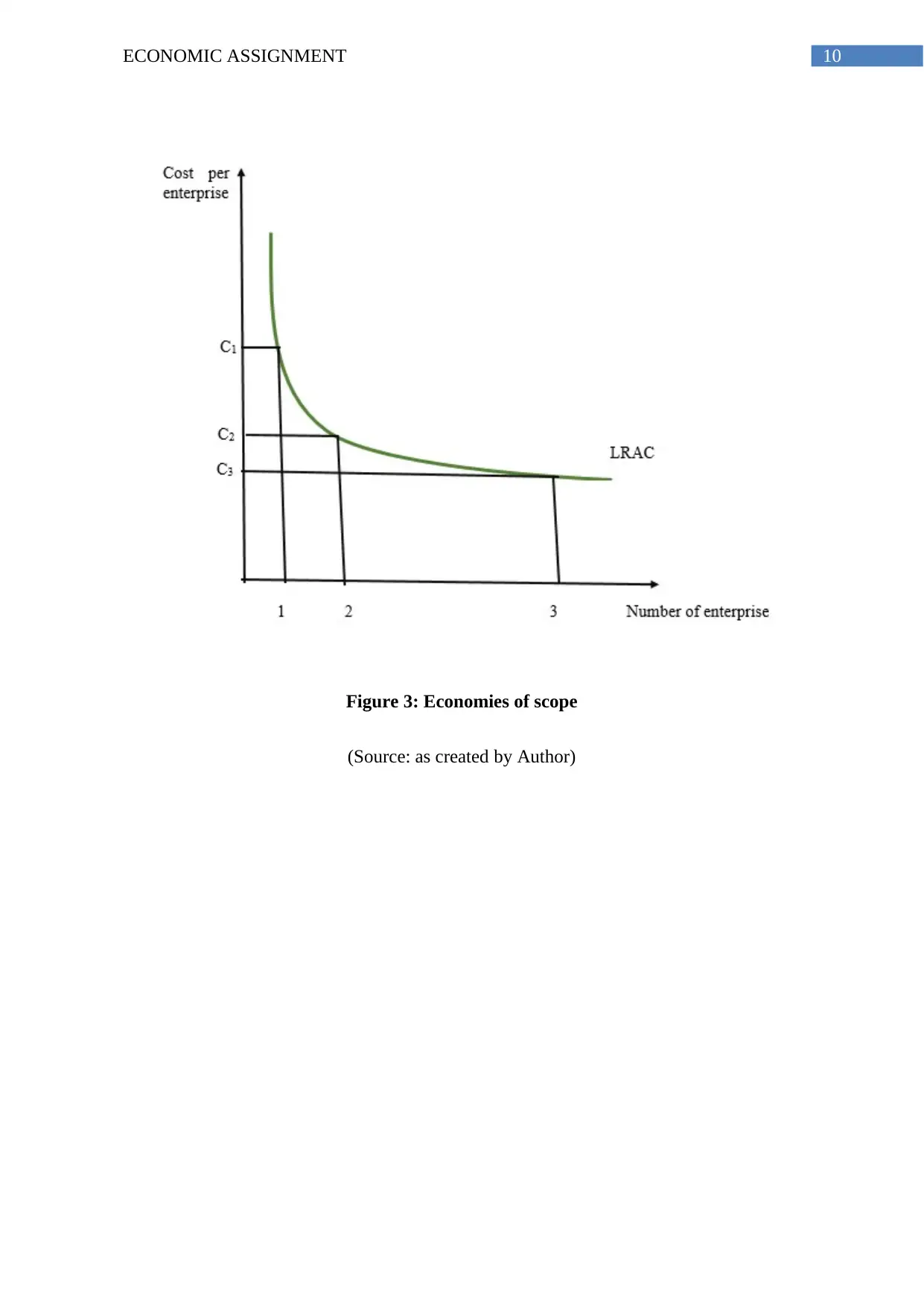
10ECONOMIC ASSIGNMENT
Figure 3: Economies of scope
(Source: as created by Author)
Figure 3: Economies of scope
(Source: as created by Author)

11ECONOMIC ASSIGNMENT
References
Aulich, C., Sansom, G., & McKinlay, P. (2014). A fresh look at municipal consolidation in
Australia. Local Government Studies, 40(1), 1-20.
Becker, G. S. (2017). Economic theory. Routledge.
Devine, P. J., Tyson, W. J., Lee, N., & Jones, R. M. (2018). An introduction to industrial
economics. Routledge.
Dollery, B. E., Kortt, M. A., & De Souza, S. (2015). Policy analysis capacity and Australian
local government. Policy Analysis in Australia, Policy Press, Bristol, 105-20.
Excise rates for tobacco. (2018). Ato.gov.au. Retrieved 19 April 2018, from
https://www.ato.gov.au/Business/Excise-and-excise-equivalent-goods/Tobacco-
excise/Excise-rates-for-tobacco/
Frank, R. H. (2015). Principles of microeconomics, brief edition. Mcgraw-Hill.
Georghiou, L., & Harper, J. C. (2015). Mergers and alliances in context. In Mergers and
Alliances in Higher Education (pp. 1-14). Springer, Cham.
Mankiw, N., & Cosgrove, S. (2014). Principles of microeconomics. Stamford, CT: Cengage
Learning.
Masser, I. (2014). Governments and geographic information. CRC Press.
McKenzie, R. B., & Lee, D. R. (2016). Microeconomics for MBAs: The economic way of
thinking for managers. Cambridge University Press.
Moulin, H. (2014). Cooperative microeconomics: a game-theoretic introduction. Princeton
University Press.
References
Aulich, C., Sansom, G., & McKinlay, P. (2014). A fresh look at municipal consolidation in
Australia. Local Government Studies, 40(1), 1-20.
Becker, G. S. (2017). Economic theory. Routledge.
Devine, P. J., Tyson, W. J., Lee, N., & Jones, R. M. (2018). An introduction to industrial
economics. Routledge.
Dollery, B. E., Kortt, M. A., & De Souza, S. (2015). Policy analysis capacity and Australian
local government. Policy Analysis in Australia, Policy Press, Bristol, 105-20.
Excise rates for tobacco. (2018). Ato.gov.au. Retrieved 19 April 2018, from
https://www.ato.gov.au/Business/Excise-and-excise-equivalent-goods/Tobacco-
excise/Excise-rates-for-tobacco/
Frank, R. H. (2015). Principles of microeconomics, brief edition. Mcgraw-Hill.
Georghiou, L., & Harper, J. C. (2015). Mergers and alliances in context. In Mergers and
Alliances in Higher Education (pp. 1-14). Springer, Cham.
Mankiw, N., & Cosgrove, S. (2014). Principles of microeconomics. Stamford, CT: Cengage
Learning.
Masser, I. (2014). Governments and geographic information. CRC Press.
McKenzie, R. B., & Lee, D. R. (2016). Microeconomics for MBAs: The economic way of
thinking for managers. Cambridge University Press.
Moulin, H. (2014). Cooperative microeconomics: a game-theoretic introduction. Princeton
University Press.
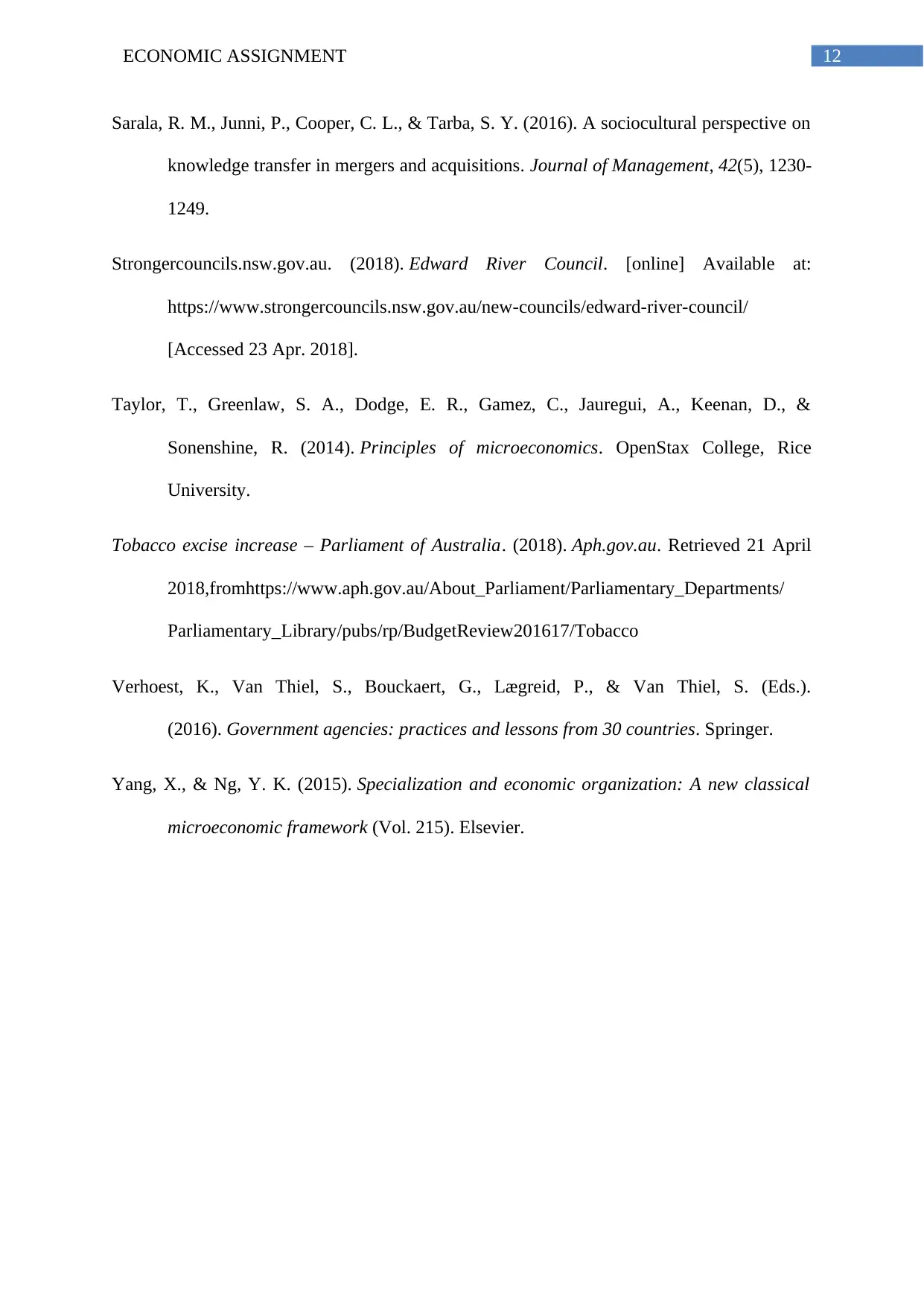
12ECONOMIC ASSIGNMENT
Sarala, R. M., Junni, P., Cooper, C. L., & Tarba, S. Y. (2016). A sociocultural perspective on
knowledge transfer in mergers and acquisitions. Journal of Management, 42(5), 1230-
1249.
Strongercouncils.nsw.gov.au. (2018). Edward River Council. [online] Available at:
https://www.strongercouncils.nsw.gov.au/new-councils/edward-river-council/
[Accessed 23 Apr. 2018].
Taylor, T., Greenlaw, S. A., Dodge, E. R., Gamez, C., Jauregui, A., Keenan, D., &
Sonenshine, R. (2014). Principles of microeconomics. OpenStax College, Rice
University.
Tobacco excise increase – Parliament of Australia. (2018). Aph.gov.au. Retrieved 21 April
2018,fromhttps://www.aph.gov.au/About_Parliament/Parliamentary_Departments/
Parliamentary_Library/pubs/rp/BudgetReview201617/Tobacco
Verhoest, K., Van Thiel, S., Bouckaert, G., Lægreid, P., & Van Thiel, S. (Eds.).
(2016). Government agencies: practices and lessons from 30 countries. Springer.
Yang, X., & Ng, Y. K. (2015). Specialization and economic organization: A new classical
microeconomic framework (Vol. 215). Elsevier.
Sarala, R. M., Junni, P., Cooper, C. L., & Tarba, S. Y. (2016). A sociocultural perspective on
knowledge transfer in mergers and acquisitions. Journal of Management, 42(5), 1230-
1249.
Strongercouncils.nsw.gov.au. (2018). Edward River Council. [online] Available at:
https://www.strongercouncils.nsw.gov.au/new-councils/edward-river-council/
[Accessed 23 Apr. 2018].
Taylor, T., Greenlaw, S. A., Dodge, E. R., Gamez, C., Jauregui, A., Keenan, D., &
Sonenshine, R. (2014). Principles of microeconomics. OpenStax College, Rice
University.
Tobacco excise increase – Parliament of Australia. (2018). Aph.gov.au. Retrieved 21 April
2018,fromhttps://www.aph.gov.au/About_Parliament/Parliamentary_Departments/
Parliamentary_Library/pubs/rp/BudgetReview201617/Tobacco
Verhoest, K., Van Thiel, S., Bouckaert, G., Lægreid, P., & Van Thiel, S. (Eds.).
(2016). Government agencies: practices and lessons from 30 countries. Springer.
Yang, X., & Ng, Y. K. (2015). Specialization and economic organization: A new classical
microeconomic framework (Vol. 215). Elsevier.
Paraphrase This Document
Need a fresh take? Get an instant paraphrase of this document with our AI Paraphraser
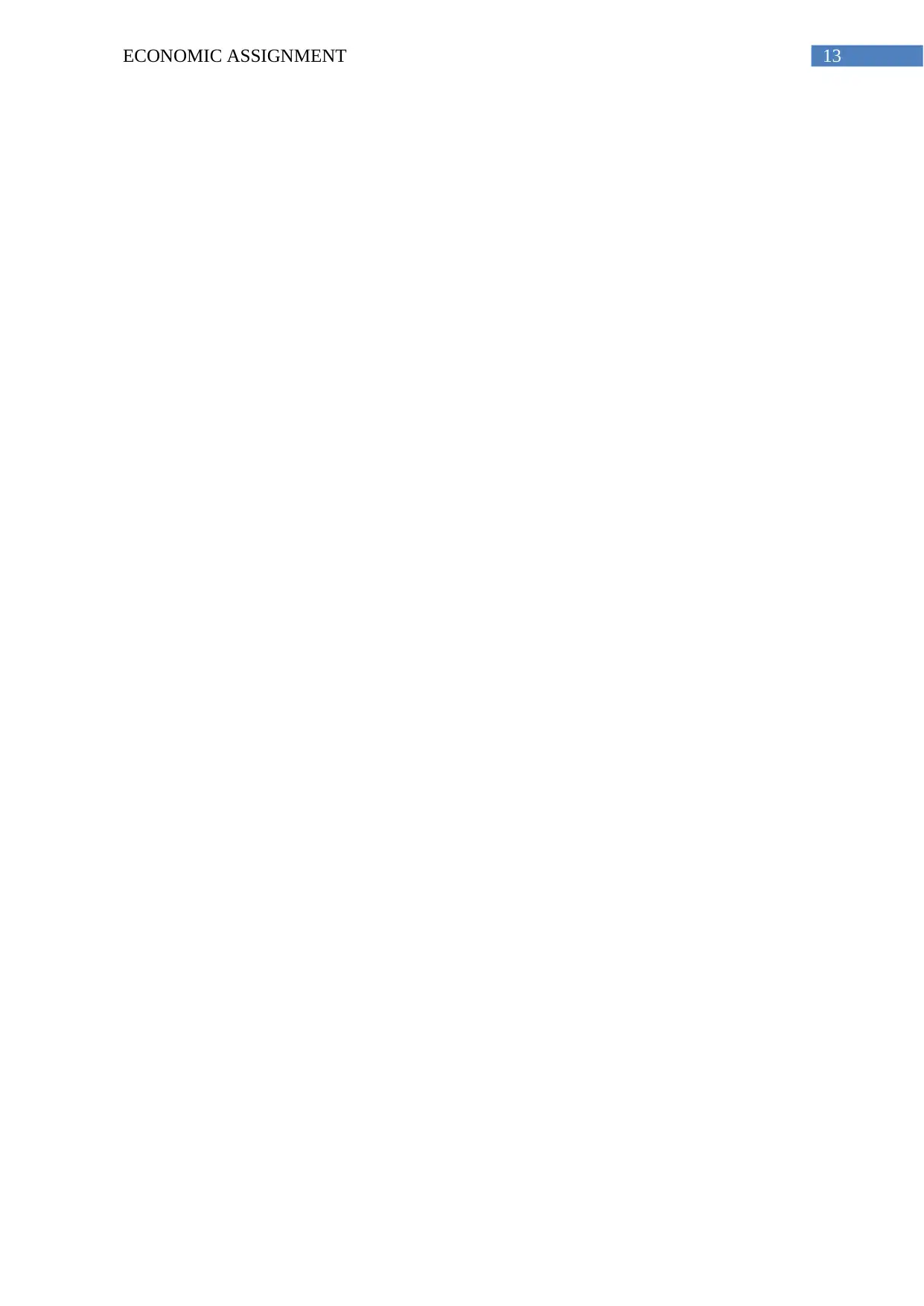
13ECONOMIC ASSIGNMENT
1 out of 14
Related Documents
Your All-in-One AI-Powered Toolkit for Academic Success.
+13062052269
info@desklib.com
Available 24*7 on WhatsApp / Email
![[object Object]](/_next/static/media/star-bottom.7253800d.svg)
Unlock your academic potential
© 2024 | Zucol Services PVT LTD | All rights reserved.





